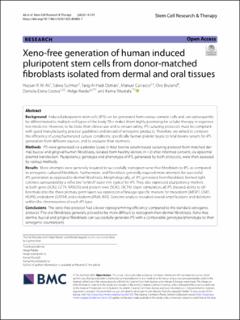Xeno-free generation of human induced pluripotent stem cells from donor-matched fibroblasts isolated from dermal and oral tissues
Ali, Hassan Abdel-Raouf Abdel-Wahab; Suliman, Salwa; Osman, Tarig Al-Hadi; Carrasco Fernandez, Manuel; Bruland, Ove; Costea, Daniela Elena; Ræder, Helge; Mustafa, Kamal Babikeir Elnour
Journal article, Peer reviewed
Published version

Åpne
Permanent lenke
https://hdl.handle.net/11250/3117198Utgivelsesdato
2023Metadata
Vis full innførselSamlinger
Sammendrag
Background
Induced pluripotent stem cells (iPS) can be generated from various somatic cells and can subsequently be differentiated to multiple cell types of the body. This makes them highly promising for cellular therapy in regenerative medicine. However, to facilitate their clinical use and to ensure safety, iPS culturing protocols must be compliant with good manufacturing practice guidelines and devoid of xenogenic products. Therefore, we aimed to compare the efficiency of using humanized culture conditions, specifically human platelet lysate to fetal bovine serum, for iPS generation from different sources, and to evaluate their stemness.
Methods
iPS were generated via a platelet lysate or fetal bovine serum-based culturing protocol from matched dermal, buccal and gingival human fibroblasts, isolated from healthy donors (n = 2) after informed consent, via episomal plasmid transfection. Pluripotency, genotype and phenotype of iPS, generated by both protocols, were then assessed by various methods.
Results
More attempts were generally required to successfully reprogram xeno-free fibroblasts to iPS, as compared to xenogenic cultured fibroblasts. Furthermore, oral fibroblasts generally required more attempts for successful iPS generation as opposed to dermal fibroblasts. Morphologically, all iPS generated from fibroblasts formed tight colonies surrounded by a reflective “whitish” outer rim, typical for iPS. They also expressed pluripotency markers at both gene (SOX2, OCT4, NANOG) and protein level (SOX2, OCT4). Upon stimulation, all iPS showed ability to differentiate into the three primary germ layers via expression of lineage-specific markers for mesoderm (MESP1, OSR1, HOPX), endoderm (GATA4) and ectoderm (PAX6, RAX). Genome analysis revealed several amplifications and deletions within the chromosomes of each iPS type.
Conclusions
The xeno-free protocol had a lower reprogramming efficiency compared to the standard xenogenic protocol. The oral fibroblasts generally proved to be more difficult to reprogram than dermal fibroblasts. Xeno-free dermal, buccal and gingival fibroblasts can successfully generate iPS with a comparable genotype/phenotype to their xenogenic counterparts.
